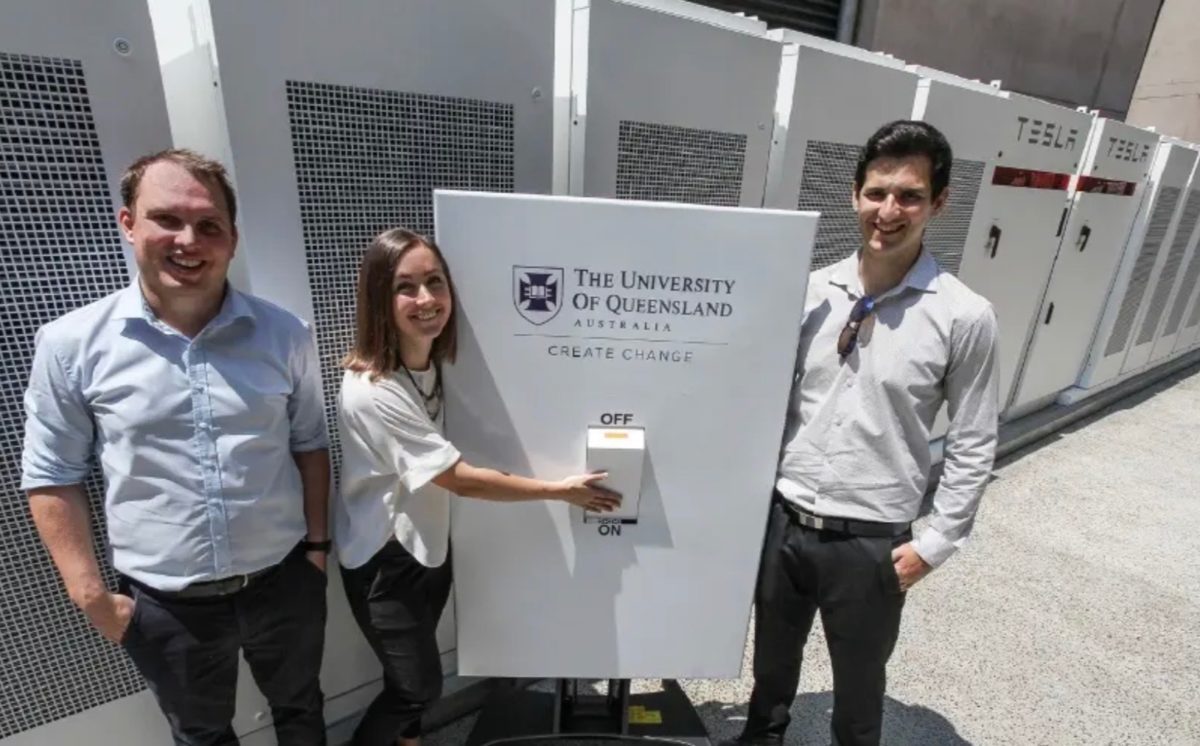In December 2019, the University of Queensland (UQ) flipped the switch on one of the state’s largest behind-the-meter battery storage systems – a 1.1 MW/2.15 MWh Tesla Powerpack.
This week, it released “The business case for behind-the-meter energy storage,” a report on the first-quarter performance of its Tesla battery. The university, which funded the Powerpack through the sale of renewable energy certificates created by its 6.3 MW behind-the-meter solar PV portfolio, hoped that the energy storage system would reduce the university’s monthly peak demand charges.
The Powerpack reduced the university’s peak demand charges, and in the first three months of this year, it actually delivered $48,300 in revenue.
Revenue driver
The university’s Powerpack has delivered revenue across several main services.

Grid frequency
The university partnered its Powerpack with Enel X, whereby it is paid to keep its battery on standby, so it’s ready to respond rapidly to sudden grid frequency issues. The National Electricity Market’s (NEM) Frequency Control Ancillary Services (FCAS) then pays the university for its storage.
FCAS outperformed the university’s forecast by a staggering 54% – an outcome that is being put down to unprecedented pressure on the NEM brought on by the past summer’s bushfires, storm events, and other issues facing Australia’s outdated grid.
Virtual cap
A virtual cap contract (VCC) is a kind of financial insurance on the wholesale electricity spot market. To manage risk in a volatile market cap, contracts are offered for a premium, and a payout is provided if the market’s prices exceed that cap. Typically, in the NEM, the threshold is $190/MWh. The university’s Powerpack is able to discharge energy when the price exceeds the threshold.
Given that the first quarter was the first real outing for the Powerpack, it has performed extraordinarily well. However, the university believes that its performance can only improve. First, it wants to develop an effective control strategy to maximize arbitrage revenue. However, this depends on the Australian Energy Market Operator producing better pre-dispatch price forecasts.
The university also believes it can improve on its FCAS and virtual cap revenue. Indeed, its financial modeling estimates that the battery could provide a financial return of $160,000 per year in a short period, and pay for itself within eight years. The expected lifetime of the battery is 15 years.
This content is protected by copyright and may not be reused. If you want to cooperate with us and would like to reuse some of our content, please contact: editors@pv-magazine.com.









In California, USA, utilties like PG&E make customers with PV panels, sign a NEM 2 agreement that has different rates for differnt times of day. The most costly rate is betwean 3:00 PM and 9:00 PM when solar power is either non existant in the winter or waining in the summer months. Batteries can cover those hours and could even buy the larger credits since the system is based on dollars and not kilo Watt hours. That is why Tesla is a year behind in battery pack instalations and is no longer offering them with their solar glass roof systems but you must add them on at a later date.
So, does this mean Sonnen could move into the territory with their eco lux smart ESS and steal customers from TESLA?
Sonnen is now backed by Shell Oil, so cash reserves is not a problem.
Solar PV is changing, with the NEC 2020 RSD (rapid shut down) requirements being moved to the panel level, how does one take the TESLA solar PV nail down product and “add” RSD on each nail down tile section to protect firemen on the roof during a daytime fire? Standard solar PV panels mounted on racks can have an RSD device mounted under each panel and could also be incorporated into a micro-inverter or D.C. converter attached to each panel. Nail down solar PV tiles, not so much.
“The Powerpack reduced the university’s peak demand charges, and in the first three months of this year, it actually delivered $48,300 in revenue. ”
In the first quarter, remediation of demand charges and actual revenue generation doing FCAS grid services for the local utility. With the largely independent attitude in Australia, I imagine within a few years residential solar PV with energy storage will curtail that “demand” period and the remaining fueled generation resources will have to look at shifting their operations to late night to early morning to try and stay profitable. That too will be hit by energy storage BTM that will look for off peak to charge the ESS day or night.
I also find it interesting at how (small) the actual micro-grid is for this establishment. 1.1MW/2.15MWh, with their existing 1.2MW solar PV system, expansion of the solar PV harvest is insinuated and perhaps a future upgrade of the energy storage system. Public entities like Colleges and Universities would do well to shed their monthly electric bills and use those funds elsewhere in the services of the entity to the public.
Now this, unlike grid batteries in well run grids, is where batteries shine at retail prices, behind the meter where they can make , save more money in multiple ways.
Now Tesla is coming out with a 10kw V2G L2 system built into their 3 onboard charger, only costs about $50 more, EV’s will become the largest storage source as near free battery dying faster from 200-300 mile range not being used, V2G solves by exercising the battery, extending battery life while making a nice income.